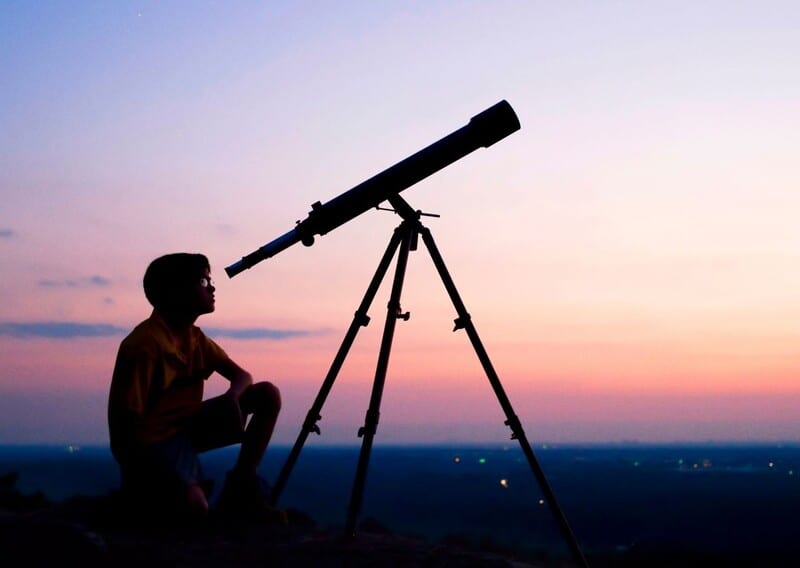I was thinking about getting a new telescope and thought; why are some telescopes long, and then some are short? Which ones are best for me, or children to use? Here is my journey to the answer.
Long telescopes have a narrow view and a higher f-ratio. Short telescopes have a lower f-ratio and a wider view. Telescopes are made longer to reduce chromatic aberrations in their lens or mirrors. The longer the telescope the less curvature of the lens and less chance for chromatic aberrations.
OK, that may be why, but what does that mean? Let us dive a little deeper all while keeping our head above water.
So What Is A Field Of View?
An easy way to demonstrate the difference is if you create an OK symbol with your hand, with the finger and thumb as a circle, hold it close to your eye and look at something. A human face will be most natural to describe because we all have one.
So, keeping your OK symbol close to your face you will be able to see their whole head and part of their body. If you then move your hand further away from your face the field of view will reduce to the point where you may then only be able to see that person’s nose.
This is how the field of view works. The long tube telescope was like when your arm was outreached, and your field of view was narrowed. The short tube telescope was like when your OK symbol was near your face.
So, Which Is Better; Long Or Short?
Much depends on what you are going to do with your telescope, (and hopefully you’re not mad, or I know that answer.) Typically most everyone states that wide field of views are better for Deep Space viewing, and Long tube narrow field of view telescopes are great for close up; like planets, and the moon. This is because close up objects are easier to find. Deep space objects, while physically more significant, they are so far away they are small and hard to find. Like how objects on the ground get as you take off on a plane, eventually the whole city blends in with everything.

This Is My Two Cents
My simple opinion is this if you are a beginner, or you have kids, or pets even. You may want to stick with a short tube rich field style telescope, and here is why. If you are a beginner, you want to see stuff, find stuff, and while you’re learning the art of astronomy, there will be a lot of setups, and tear downs.
Also, as you get used to the hobby, you may bump a long scope turning for a sip of coffee. Now you have to have to try and find it again, or worse, reset up the telescope. Plus, kids will want to have a look and inadvertently bump or lean on a long tube telescope.
You probably got my point by now, and it is just my opinion, and to top it off, you can upgrade your eyepieces that can help and sometimes correct the chromatic aberrations you may have with the short tube rich field of view telescopes.
A long tube scope is more for an intermediate skilled user where you start to demand cleaner imaging through the eyepiece. You also have the experience now to find objects in the night sky where the narrow field of view isn’t an inhibition.
Are There Other Types Of Telescopes?
Yes, there are reflector type telescopes. The same principle of short and long apply, but you have a mirror that is concave on one side to focus its light to a second mirror on the opposite end opposite end of the telescope. This mirror is flat and on a 45-degree angle to the primary mirror.
The 45 degree is so the image can go out to an eyepiece. Sometimes they design the scope to reflect back again, so the eyepiece is at the back like a refractor style. It is here where the magnification happens, from the eyepiece to the 45-degree mirror.
Like I had mentioned, the longer the scope, the less curvature needed, so less concave to the mirror. Therefore, less distortion in your celestial views. A famous telescope that is designed like this is Hubble.
Because of my discouraging outcome of my first telescope, I always wanted to get the Celestron 8, a reflective type telescope technically a cross between a refractor and a reflector. You could get camera attachments, oh yeah, I wanted one. Here is what one on Amazon is now.
Which One Cost Less, Long or Short Tube?
Typically, the longer tube is less expensive, regardless to the image being better, or the magnification being greater. This is most likely based on the ease of manufacture of the lenses.
Still, unless you are experienced a little bit, even with binoculars. Many experts recommend starting with binoculars because they tend to have a wide field of view, easy to find things, and you can easily use them for tons of other things. Without experience, I would still cough up the 10-20% more for a short tube. Trying to find Saturn will be just a little easier unless you have had experience doing so before.
Which Tube Style Is Best For Photography?
It turns out Short Tube telescopes are better for photography because of their wide field of view. More specifically an apochromatic refractor telescope is best for photography, and or astrophotography. The lens material is specially designed to minimize chromatic aberration seen in less expensive short-tube telescopes.
Something I may not have mentioned before now is a refractor style scope requires less set up and is more rugged for possible travel. The lens are mounted and set. In telescope talk, they are collimated at the factory and should never need collimating.
But, if you have the camera adapters, you can take a picture with any telescope. If you are buying a telescope just to take pictures, then you should go with a short tube with apochromatic lenses.
What Kind Of Tripod Or Stand Is Best For Each?
You can kind of use the simple approach here. If it seems sturdy and rugged, it is most likely good. My son used to say as a kid “oh it’s heavy, you know it’s good.” You can typically tell quality no matter what it is made of. Most all are made of aluminum, wood, or stainless steel any more. The heavy the scope the beefier the stand.
To be honest, there are so many different sizes and styles of telescopes that give way to a wide range of weights of each telescope. It is safe to assume that if your telescope came with a tripod, you are good to go. If you do need to buy a telescope, or you want to upgrade to a stand with an equatorial mount if you don’t have one now.
Just weigh your scope and don’t go over the recommended limit of your new stand. The problem is probably more a tip over issue than structural integrity under load problem. Check out How Much Does Your telescope Weigh, A comparative guide.
However, you can see our tips and tricks article where we talk about attaching weight to the eyepiece tray to lower the center-of-gravity and make the telescope more stable. A great little tip just in case a little bit of wind picks up!
Need More?
There is no real right or wrong for anyone person because everybody is different. With that said, here are some articles that will help you discriminate between the styles and choose what is right for you!
What To Look For When Buying A Used Telescope


